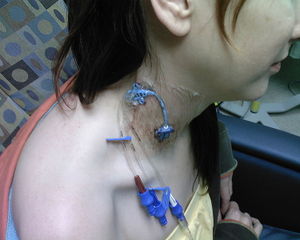We need you! Join our contributor community and become a WikEM editor through our open and transparent promotion process.
Central line: internal jugular
From WikEM
Contents
Indications
- Central venous pressure monitoring
- High volume/flow resuscitation
- Emergency venous access
- Inability to obtain peripheral venous access
- Repetitive blood sampling
- Administering hyperalimentation, caustic agents, or other concentrated fluids
- Insertion of transvenous cardiac pacemakers
- Hemodialysis or plasmapheresis
- Insertion of pulmonary artery catheters
Contraindications
Absolute[1]
- Infection over the placement site
- Anatomic obstruction (thrombosis of target vein, other anatomic variance)
- Site-specific
- Subclavian - trauma/fracture to ipsilateral clavicle or proximal ribs
Relative
- Coagulopathy (see below)
- Distortion of landmarks by trauma or congenital anomalies
- Prior vessel injury or procedures
- Morbid obesity
- Uncooperative/combative patient
Central line if coagulopathic
- Preferentially use a compressible site such as the femoral location (avoid the IJ and subclavian if possible)
- No benefit to giving FFP unless artery is punctured[2]
- However, consider giving FFP if patient has hemophilia[3]
Equipment Needed
- CVC kit typically contains:
- Chlorhexidine
- Sterile drape
- 1% lidocaine without epinephrine
- 5 mL syringe (for lidocaine)
- 22-ga and 25-ga needles (for lidocaine)
- 5-10 mL syringe (for venipuncture)
- 18-ga needle (for venipuncture)
- Guidewire
- Scalpel with 11-blade
- Dilator
- Triple-lumen catheter (or introducer catheter/Cordis)
- Catheter clamp
- Silk suture
- Sterile gown, cap, mask, gloves
- Biopatch
- Tegaderm
- Sterile saline flush
- Sterile caps for lumen ports
Procedure
Ultrasound-guided
- Obtain informed consent when possible
- Trendelenberg is ideal position
- Ultrasound survey to identify anatomy before beginning
- Don cap, mask, sterile gown and gloves
- Chlorhexidine prep the skin. Right sided approach preferred
- Place sterile drape over target area
- With assistant, place sterile cover over ultrasound probe, with some gel inside, secured with rubber bands from probe cover package
- Anesthetize insertion site
- Prepare catheter by flushing each lumen with sterile saline
- Prepare the guide wire by sliding the plastic sleeve slightly forward to straighten the curved wire tip
- Using ultrasound, identify IJ vein and carotid artery - large bore vessels, medial/deep to SCM. Vein is compressible, artery non-compressible.
- Align IJ in center of ultrasound screen
- Insert needle with syringe under ultrasound guidance, while applying negative pressure on the syringe
- When the needle enters the lumen, blood will be aspirated freely
- Stabilize the needle hub, carefully remove the syringe from the needle
- Confirm blood flow is non-pulsatile. Cap needle hub with thumb to avoid air embolism
- Insert the guidewire in through the needle hub, never letting go of the wire. If resistance is met, remove the wire and aspirate with syringe to confirm placement still in the vessel
- Remove the needle, keeping the wire in the vessel
- Make a small incision to facilitate dilator passage through the skin
- Thread the dilator over the wire, and advance several centimeters into the vessel, then remove, while keeping the wire in the vessel
- Advance the catheter over the wire, until the wire protrudes from a distal port (For introducer catheters, the dilator and larger single-lumen catheter are inserted as a dilator-sheath unit, assembled prior)
- Grasp the wire where it emerged from the port and advance the catheter into the vessel
- Remove the wire
- Place end cap on port
- Withdraw blood then flush each port/lumen with saline
- Suture the catheter in place
- Place Biopatch
- Cover with Tegaderm
Landmark technique
- Same preparation as above, differences from ultrasound method highlighted below
- Rotate head 15-30 deg away from target side
- Anterior approach
- Insert needle along medial edge of SCM, 2-3 finger breadths above clavicle
- Entry angle 30-45 deg
- Aim towards ipsilateral nipple
- Central approach
- Insert needle at the apex of the triangle formed by the heads of the SCM and the clavicle
- Entry angle 30 deg
- Aim towards ipsilateral nipple
- Posterior approach
- Insert needle at the posterior (lateral) edge of the SCM, halfway between the mastoid and the clavicle
- Entry angle 45 deg
- Aim for the suprasternal notch
Complications
- Arterial puncture and hematoma
- Pneumothorax
- Hemothorax
- Vessel injury
- Air embolism
- Cardiac dysrhythmia
- Nerve injury
- Infection
- Thrombosis
- Catheter misplacement
See Also
References
- Roberts & Hedges 6e, pp 397-431
- ↑ Graham, A.S., et al. Central Venous Catheterization. N Engl J Med 2007;356:e21
- ↑ Fisher NC, Mutimer DJ. Central venous cannulation in patients with liver disease and coagulopathy—a prospective audit. Intens Care Med 1999; 25:5
- ↑ Morado M.et al. Complications of central venous catheters in patients with haemophilia and inhibitors. Haemophilia 2001; 7:551–556

